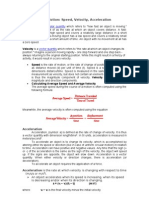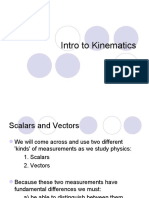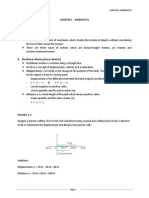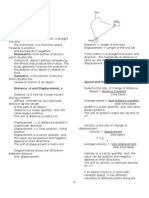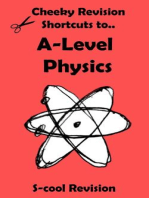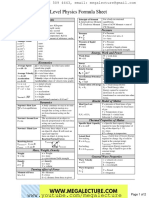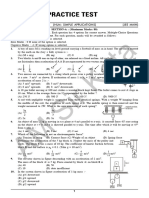BB101 Chapter 2 Linear Motion - Edit
Uploaded by
Aidi AmarBB101 Chapter 2 Linear Motion - Edit
Uploaded by
Aidi AmarLINEAR MOTION
BB101- ENGINEERING SCIENCE
2.0
LINEAR MOTION
2.1 Scalar and Vector Quantity A scalar quantity is a quantity that has magnitude, but no direction. A vector quantity is a quantity that has both magnitude and direction. Table shows examples of scalar and vector quantities.
Scalar quantity Distance Area Speed Vector quantity Displacement Acceleration Force
2.2 Linear Motion Linear motion is motion in a straight line. Example of linear motion are: a) A car moving in a traight line. b) A passenger carried by the moving escalator. Example of non-linear motion are: a) A snake crawling. b) A top spinning. 2.3 Uniform and nonuniform motion Uniform motion : a constant steady speed or motion. On a graph it appears as a straight line going neither up nor down. Motion moving in a straight line at a constant speed. Nonuniform motion : Most of the motion that we come across in daily life is non-uniform motion. Moving objects are either 'speeding up' or 'slowing down'. In non-uniform motion, the velocity of the moving object changes, as a result of which the object is said to have an acceleration. 2.4 Distance and Displacement
Distance travelled by an object is the total length that is travelled by that object. Distance is a scalar quantity. The SI unit of distance is m (metre). Displacement of an object from a point of reference, O is the shortest distance of the object from point O in a specific direction. Displacement is a vector quantity. The SI unit of displacement is m (metre).
UNIT SAINS JMSK PUO/JUN 2012
Page 10
LINEAR MOTION
BB101- ENGINEERING SCIENCE
Distance vs Displacement
Distance travelled = 200m Displacement = 120 m, in the direction of Northeast
Comparison between distance and displacement Aspect Definition Type of quantity SI unit Distance Total route taken by a motion Scalar quantity-with magnitude only Displacement Distance taken with consideration of direction Vector quantity-direction and magnitude are important Metre (m)
2.5
Speed and Velocity
Speed is a scalar quantity which refers to "how fast an object is moving." Speed can be thought of as the rate at which an object covers distance. An object with no movement at all has a zero speed. Speed = distance travelled/time taken Velocity is a vector quantity which refers to "the rate at which an object changes its position." Velocity = displacement/time Comparison between speed and velocity Aspect Speed Definition Rate of change of distance Type of Scalar quantity-with magnitude quantity only Formula SI unit 2.6 Average velocity & Instantaneous velocity Velocity shows how fast an object is moving to which direction.
UNIT SAINS JMSK PUO/JUN 2012 Page 11
Velocity Rate of change of displacement Vector quantity-direction and magnitude are important ms-1
LINEAR MOTION
BB101- ENGINEERING SCIENCE
Average velocity can be calculated by dividing displacement over time. For example, when a car moved 50 km in 2 hours, the average velocity is 25.5 km/h because
The instantaneous velocity shows the velocity of an object at one point. For example, when you are driving a car and its speedometer swings to 90 km/h, then the instantaneous velocity of the car is 90 km/h.
2.7
Acceleration and deceleration a) An object accelerates when its velocity changes with time. Acceleration is defined as the rate of change of velocity with time.
b) The acceleration of an object is regarded as positive if its velocity increases and negative if its velocity decreases. Negative acceleration is also known as deceleration. c) An object is said to move with uniform acceleration if the rate of change of its velocity is constant. d) An object is said to move with zero acceleration if its velocity remains constant. Examples a) A car increases its velocity steadily from 72 km h-1 to 108 km h-1 in 5 s. What is its acceleration in m s-2? Solution ,
, , ,
-2
b) An object moves from rest with a uniform acceleration of 2 m s . What is the velocity of the object after 30 s? Solution , , , , , c) A car moving at constant velocity of 30 cm s-1 came to a stop 6 s after its brake was applied. What was the deceleration of the car? Solution ,
, , , ,
2.8
Equations of Linear Motion
Problems on linear motion with uniform acceleration can often be solved quickly using the equations of motion. The following symbols are used in the equations of motion.
UNIT SAINS JMSK PUO/JUN 2012 Page 12
LINEAR MOTION
BB101- ENGINEERING SCIENCE
There are four equations of linear motion, that are: Examples a) A car is accelerated at 6 m s-2 from an initial velocity of 2 m s-1 for 10 seconds. What is the final velocity, and the distance moved? Solution , , ,
b) A driver travelling at a velocity of 108 km h-1 notices a cow in the middle of the road
80 m in front of him. On seeing the cow. The driver instantly applies the brakes and is able to bring the car to a stop after 6 seconds. i. What is the deceleration of the car? ii. Calculate the distance travelled by the car from the time the driver applies the brakes until it comes to a stop. iii. Is the driver able to avoid knocking the cow?
Solution
UNIT SAINS JMSK PUO/JUN 2012
Page 13
LINEAR MOTION
BB101- ENGINEERING SCIENCE
c)
A ball is thrown vertically upwards with an initial velocity of 15 m s-1. Neglecting air resistance, find i. ii. The maximum height reached, The time taken before it reaches the ground. (Acceleration due to gravity = 10 m s-2)
Solution
2.9
Analysing Motion Graphs A velocity time graph shows how the velocity of an object changes with time. The gradient of a velocity time graph represents the acceleration of the object. The area under a velocity time graph represents the distance travelled by the object.
Velocity Time Graph
UNIT SAINS JMSK PUO/JUN 2012
Page 14
LINEAR MOTION
BB101- ENGINEERING SCIENCE
Solving Problems using Graphs which show linear motion Example: A car moving at a velocity of 30 ms-1 accelerates constantly and reaches a velocity of 35 ms-1 in 6 seconds. The car moves with a velocity of 35 ms-1 for 30 seconds. The car then stops for 4 seconds. Calculate: (a) the acceleration for the first 6 seconds. (b) the deceleration for the last 4 seconds. (c) the total distance travelled (a)
Velocity/ms 35 me 30 /s
-1
B C
Time/s 6 m e / s 36 40
Given : = (b) Given: a=
=
Page 15
UNIT SAINS JMSK PUO/JUN 2012
LINEAR MOTION
BB101- ENGINEERING SCIENCE
(c) Total distance = Area below the graph = Area A + Area B + Area C = = 195 + 1 050 + 70 = 1 315 m
(35
Study of Motion with the Ticker Timer:
UNIT SAINS JMSK PUO/JUN 2012
Page 16
LINEAR MOTION
BB101- ENGINEERING SCIENCE
2.10 Exercises 1.Give the definition and unit for each of the following. a)Displacement b)Distance c)Velocity d)Speed e)Acceleration
2. State the difference between : a) distance and displacement b) speed and velocity c) acceleration and deceleration d) Scalar quantities and vector quantities 3. A car moves in a straight line from its stationary state with a uniform acceleration. It achieves a velocity of 120 m/s after moving through a distance of 500m. Calculate , i. The acceleration of the car ii. The time taken iii. The velocity when t=3 s 4. A car moving at a velocity of 20m/s accelerates constanly and reaches a velocity of 30m/s in 10 seconds. The car moves with a velocity of 30m/s for 30 seconds. The car then stops for 5 seconds. Calculate, i. The acceleration for the first 10 seconds ii. The deceleration for the last 5 seconds iii. The total distance travelled 5. A ball is thrown vertically upwards with an initial velocity of 20m/s . Calculate i. The maximum height of the ball ii. The total time the ball is in the air, ( take g = 9.81 m/s2 ) iii. The time to reach a height of 15 m iv. The velocity when the ball is at height of 15m. 6. Figure shows a velocity time graph for a moving object
i. ii. iii. 7.
State the meaning of each lines P, Q, and R. What is the acceleration of the objects in the first 2 seconds? What is the total distance of the object? A car starts from rest and accelerates at a constant acceleration of 2m/s2 for 5 s. The car then travels at a constant velocity for 9 s . The brakes are then applied and the car stops in 6 s. What is the maximum velocity attained by the car? (i) Plot a velocity-time graph for the whole journey. (ii) From the graph-plotted, determine the total distance travelled.
Answer: 3. i. 14.4m/s2 ii. 8.3 s iii. 43.2m/s 4. i. 1m/s2 ii. -6m/s2 iii. 415m 5. i. 20.4 m ii. 4.08s iii. 0.99s iv. 10.29m/s 6. ii. 2.5 m/s iii. 45m 7. 10m/s (ii) 145m
Minimum requirement assessment task for this topic:
1 Theory Test & 1 Lab work Specification of Theory Test : CLO1 - C1 & CLO3 (C2, A1) UNIT SAINS JMSK PUO/JUN 2012 Page 17
LINEAR MOTION
BB101- ENGINEERING SCIENCE
Specification of lab work: CLO2 - (C2,P1)
***************************************************************************************** COURSE LEARNING OUTCOME (CLO) Upon completion of this topic, students should be able to: 1. 2. 3. Identify the basic concept of linear motion, (C1) Apply concept of linear motion to prove related physics principles. (C2,P1) Apply the concept of linear motionin real basic engineering problems. (C2,A1)
Compliance to PLO : PLO1 , LD1 (Knowledge) Test 1 PLO2, LD2 (Practical Skill) Experiment 2 PLO4, LD4 (Critical Thinking and Problem Solving Skills) Test 1
UNIT SAINS JMSK PUO/JUN 2012
Page 18
You might also like
- SMK Tat Beng Physics Form 4 2.1 Linear MotionNo ratings yetSMK Tat Beng Physics Form 4 2.1 Linear Motion69 pages
- Motion Class 9 Science Important QuestionsNo ratings yetMotion Class 9 Science Important Questions9 pages
- Answer Key - Worksheet - MOTION AND TIMENo ratings yetAnswer Key - Worksheet - MOTION AND TIME4 pages
- Science Booklet Prep 3 First Term 2015-2016No ratings yetScience Booklet Prep 3 First Term 2015-201650 pages
- model answer prep 3 booklet t1 2025-1-13No ratings yetmodel answer prep 3 booklet t1 2025-1-1313 pages
- Uniform Motion Word Problems and Acceleration NotesNo ratings yetUniform Motion Word Problems and Acceleration Notes26 pages
- Planar Linkage Synthesis: A modern CAD based approachFrom EverandPlanar Linkage Synthesis: A modern CAD based approachNo ratings yet
- List of Important Derivations/topics of Physics Class XI CBSE82% (11)List of Important Derivations/topics of Physics Class XI CBSE2 pages
- Unit 1: Conservation Laws: Energy ReviewNo ratings yetUnit 1: Conservation Laws: Energy Review19 pages
- Electricity Electrical Potential Difference and Potential EnergyNo ratings yetElectricity Electrical Potential Difference and Potential Energy4 pages
- Electric Charge, Coulomb'S Law, Electric Fields, and Electric FluxNo ratings yetElectric Charge, Coulomb'S Law, Electric Fields, and Electric Flux7 pages
- Sources of Magnetic Field: Powerpoint Lectures ForNo ratings yetSources of Magnetic Field: Powerpoint Lectures For20 pages
- General Physics1 Quarter 1 Module 6 Quantities in Circular MotionNo ratings yetGeneral Physics1 Quarter 1 Module 6 Quantities in Circular Motion19 pages
- Chernobyl - Chernobyl Accident - Chernobyl DisasterNo ratings yetChernobyl - Chernobyl Accident - Chernobyl Disaster15 pages
- 2) - Gauss' Law and Applications: R Q Q 4 1 Q Q 4 1No ratings yet2) - Gauss' Law and Applications: R Q Q 4 1 Q Q 4 118 pages
- Divine Life Institute of Cebu, Inc.: General Physics 2No ratings yetDivine Life Institute of Cebu, Inc.: General Physics 24 pages
- CBSE Class 11 Physics Important Questions Motion in A Straight LineNo ratings yetCBSE Class 11 Physics Important Questions Motion in A Straight Line14 pages
- PT-02 - JEE-PHY - NL02 - Simple Appplication - SCNo ratings yetPT-02 - JEE-PHY - NL02 - Simple Appplication - SC4 pages
- Ee8391 - Electromagnetic Theory: Unit 1-Introduction Two Marks0% (1)Ee8391 - Electromagnetic Theory: Unit 1-Introduction Two Marks43 pages
- Uniform Motion Word Problems and Acceleration NotesUniform Motion Word Problems and Acceleration Notes
- A Complete Course in Physics (Graphs) - First EditionFrom EverandA Complete Course in Physics (Graphs) - First Edition
- Exercises of Kinematics, Dynamics and StaticsFrom EverandExercises of Kinematics, Dynamics and Statics
- A-level Physics Revision: Cheeky Revision ShortcutsFrom EverandA-level Physics Revision: Cheeky Revision Shortcuts
- Planar Linkage Synthesis: A modern CAD based approachFrom EverandPlanar Linkage Synthesis: A modern CAD based approach
- List of Important Derivations/topics of Physics Class XI CBSEList of Important Derivations/topics of Physics Class XI CBSE
- Electricity Electrical Potential Difference and Potential EnergyElectricity Electrical Potential Difference and Potential Energy
- Electric Charge, Coulomb'S Law, Electric Fields, and Electric FluxElectric Charge, Coulomb'S Law, Electric Fields, and Electric Flux
- Sources of Magnetic Field: Powerpoint Lectures ForSources of Magnetic Field: Powerpoint Lectures For
- General Physics1 Quarter 1 Module 6 Quantities in Circular MotionGeneral Physics1 Quarter 1 Module 6 Quantities in Circular Motion
- Chernobyl - Chernobyl Accident - Chernobyl DisasterChernobyl - Chernobyl Accident - Chernobyl Disaster
- 2) - Gauss' Law and Applications: R Q Q 4 1 Q Q 4 12) - Gauss' Law and Applications: R Q Q 4 1 Q Q 4 1
- Divine Life Institute of Cebu, Inc.: General Physics 2Divine Life Institute of Cebu, Inc.: General Physics 2
- CBSE Class 11 Physics Important Questions Motion in A Straight LineCBSE Class 11 Physics Important Questions Motion in A Straight Line
- Ee8391 - Electromagnetic Theory: Unit 1-Introduction Two MarksEe8391 - Electromagnetic Theory: Unit 1-Introduction Two Marks


